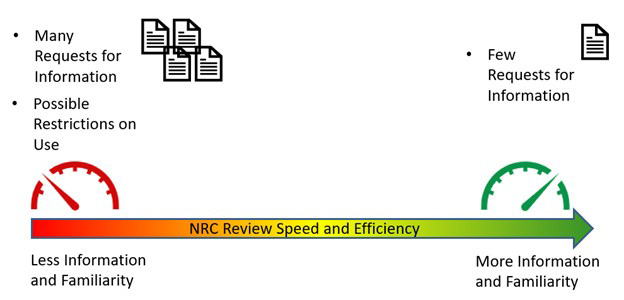NRC Readiness to License Accident Tolerant Fuel Technologies
This page includes links to files in non-HTML format. See Plugins, Viewers, and Other Tools for more information.
This question is often asked by the industry, public stakeholders, and internally within the NRC. "Is the NRC ready to review Accident Tolerant Fuel (ATF) technologies?" This question can be separated into two, which highlight the NRC's approach to ATF:
- Is the NRC capable of reviewing accident tolerant fuel submittals today?
- Is the NRC capable of reviewing submittals on the licensees' and vendors' requested, expedited, timelines?
For Question 1: The NRC is capable of reviewing accident tolerant fuel submittals today. The near-term technologies (coated cladding, doped pellets), increased enrichment, and higher burnup can be licensed if submitted today without any changes to the current regulations and guidance. Additionally, the NRC employs a number of experts in nuclear fuel with a broad range of experience in nuclear fuel performance. The NRC's nuclear fuel experts follow state-of-the-art developments in nuclear fuel by participating in international conferences, reading peer-reviewed journals, and attending training courses. The NRC's nuclear fuel experts have been following bi-annual ATF technology update meetings, where the latest research on ATF technologies is presented, for over 4 years.
However, the efficiency and speed of the review is strongly correlated to the quality of the information provided in the submittal, and the NRC familiarity with and prior exposure to that information. If the NRC staff finds the application lacking in components, the vendors or licensee may have to obtain that information or could have restrictions on the technology's use (i.e., topical report limitations and conditions, license conditions). If the NRC is not well versed in the technology, then the NRC may face a learning curve on the information before it is able to complete the review. Either of these situations could result in significant delays.
For Question 2: The NRC has developed the ATF Project Plan to communicate how the agency is preparing for near-term ATF technologies, longer-term ATF technologies, higher burnup, and increased enrichment. The ATF Project Plan outlines a strategy to perform efficient reviews of submittals within the expedited timelines requested by the vendors and licensees through a new paradigm. The new paradigm highlights the NRC's plan to start refining the regulatory infrastructure (i.e., regulations and guidance) prior to the completion of the technical bases. This can only be accomplished with a higher level of communication and coordination with stakeholders than in the past.
As stated above, the speed and efficiency at which the NRC can review applications (and whether the requested timelines are able to be met) is highly dependent on the quality of the application and NRC staff's familiarity with the content. With increased information, exposure, and familiarity ahead of the application submission, the possibility decreases for surprises that result in review delays and restrictions on the technology's use.

One example of an ATF Project Plan success is the issuance of the interim staff guidance (ISG) for chromium-coated cladding. The early completion of a PIRT report and NRC staff's interactions with stakeholders resulted in sufficient information and familiarity with coated cladding technologies that the ISG could be issued prior to the NRC receiving any chromium-coated cladding applications. The ISG defines the issues that the staff expects to be addressed in chromium-coated cladding applications and consolidates available information on each issue to aid the staff as they review the application. With the ISG, it is much more likely the NRC staff will be able to review submittals under the requested timelines, as long as the submittals are of high quality.